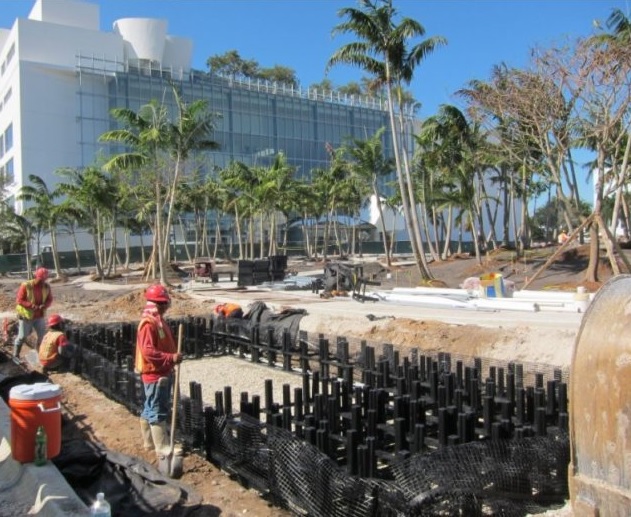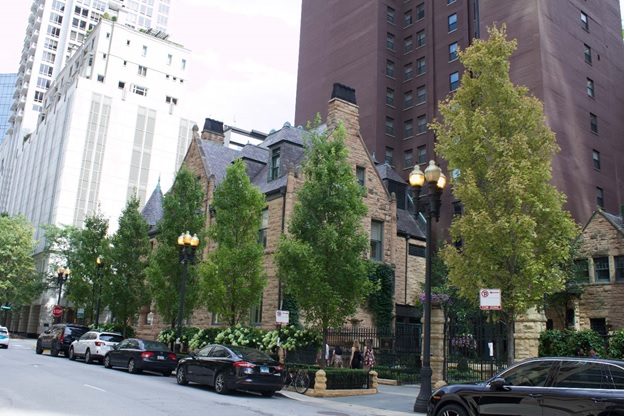Introduction
The question of how much soil is required to grow a big tree is one that has been debated among arborists and landscape architects for decades — and the answer isn’t black and white. Space, pollutants, and engineering requirements are all major considerations that affect the growing conditions of urban trees. And, other than selecting a climate-appropriate tree, soil availability may be the biggest factor in the success or failure of the tree’s growth.
One thing that isn’t well understood, especially on a policy level, is just how much soil it takes to a grow a big, healthy tree in a built urban environment. Likewise, the team-building efforts necessary to prioritize the trees’ growth requirements are often prohibitive: the public right of way is a shared space with many constituencies involved — cars, buses, water, electric, gas, and other utilities compete for space and dollars. The question of “how much soil does a tree need?” must compete with the list of utility and construction limitations; significant downward pressure exists to give the tree the absolute minimum possible soil.
Conventional wisdom suggests that 1,000 cubic feet of soil is required to grow a large tree — and inevitably, this number is challenged when specifiers begin asking questions like “Is 750 cubic feet enough?” or “Can we avoid it by getting 400 cubic feet in shared rooting volumes?” Ultimately, this 1,000 cubic-feet axiom needs reconsideration. Indeed, by most measurements, 1,000 cubic feet of soil will only grow a medium-sized tree. Allowing as much soil volume as possible will guarantee the health and vitality of the tree. And, in tandem with raising the standard number, we need to begin prioritizing soil volume on a policy level to ensure we are creating optimal conditions for the healthiest possible urban forests.

Top photo: 2008 / Bottom photo: 2018. New York City: Julliard near Lincoln Center for the Performing Arts. Planted with appropriate soil-volume levels in 2008, the trees are thriving in 2018.
The Start of Tree Soil Volume Science
Where, exactly, did the 1,000 cubic feet of soil axiom originate? In 1992, James Urban (FASLA) published some data in the Journal of Arboriculture from Nina Bassuk at Cornell University, and others. Bassuk’s research asserted that 2 cubic feet of every square foot of crown projection (metric=.66 cubic meters per square meter of crown projection) is a standard rule of thumb, displaying examples of this equation on a graph. Urban highlighted one of these easily understood examples — at 1,000 cubic feet — and the myth was born.
The myth then took hold within the industry; the chart has since been copied hundreds of times in planting manuals and policy documents — including the Landscape Architectural Graphic Standards. As it turns out, the 1,000 cubic-foot rule only allows for the growth a medium-sized tree. Similarly, site-specific factors are often ignored in favor of the simple 1,000 cubic-foot myth: water use (a central tenant of Bassuk’s research), for example, often goes unmentioned when discussing soil volume requirements. Likewise, field capacity, evapotranspiration rates, leaf area index, and climate conditions are also ignored.
Indeed, climate conditions are an important factor when considering your soil-volume needs. Growing a Red Maple tree in the New York area may only require 1,000 feet of cubic soil volume, whereas the same Red Maple would need 4,000 feet of cubic soil for comparable growth in Phoenix, Arizona. In short, areas with hotter and drier climates require more soil volume. Take the trees featured in the below images, for example. They make look similar, but because of the climate conditions present in their regions — Seattle on the top and Oklahoma City on the bottom — their soil volume needs were very different: the tree on the bottom required much more soil to offset the city’s hotter, drier weather.

Top photo: Seattle / Bottom photo: Oklahoma City. Courtesy of Site Workshop Landscape Architecture and OJB Landscape Architecture.
Other Factors to Consider
When you look at a Silva Cell site, you can tell how big a tree will grow by the extent of the cells. The West 8 project at the New World Symphony in Miami Beach featured below demonstrates how large this live oak tree will grow before potentially becoming soil starved.


Top photo: 2009 / Bottom photo: 2018
It’s important to remember that, when it comes to planting a tree, the same amount of wood is above ground as below it. The morphology of the shoots versus the roots is different, but the weight is equal.
What are the implications of this? It means that if the designer wants an overarching canopy from tree to tree, they will have to link the trees with soil so that the canopy follows where the roots will grow. On the municipal scale, the implication of tree physiology is even greater (and largely ignored): those cities with aggressive canopy goals of 40-50% coverage will have to create soil-rooting volume of half their real-estate area to achieve the shading necessary to reduce urban heat island effect.
What about different kinds of trees? Do those with smaller crown projections require smaller soil volumes? Not necessarily. Trees with a narrow canopy eventually tend to spread like their wider cousins: as it grows, it becomes wider and less columnar. More research is necessary to answer this question; in the meantime, we recommend assuming that a spreading tree and a columnar of the same genus should receive access to comparable soil volume. Likewise, palm trees and hedges may require different considerations — see our blog for more detailed information.


A side-by-side example of trees with narrow and wide spread (Chicago Driehaus Capital on top and Minneapolis Westminster Presbyterian Church on bottom).
Hurricane areas also have unique soil-volume considerations. Researchers who visited post-hurricane sites found that many incidents of tree failure could have been prevented with appropriate design and management. A strong root system is perhaps the most critical factor when determining how trees will withstand hurricane-force winds in urban landscapes. Strategies for developing strong root systems for newly planted trees, and preserving the roots of existing trees, is essential. For more information, see Gilman and Partin’s study on wind resistance in urban forests.
Use Your Head
Trees need an adequate volume of root, oxygen-rich soil to thrive — and minimum soil volume practices are a powerful tool for advocates to leverage better growing conditions for trees, especially in urban areas. While the 1,000 cubic-foot standard was a helpful rudimentary rule of thumb, the industry has progressed beyond that paltry number. Aiming for 2,500 cubic feet is, while ambitious, a more appropriate target to ensure the growth of large, healthy trees. While not all areas can accommodate this kind of soil volume, and other factors such as budget and site-specific obstacles often prevent this from being achievable, there are solutions to help us attain this goal — including suspended pavement, soil sharing, and root corridors from tree pits to nearby soil volumes like lawns and parks. The more soil volume that can be provided, the great chance of creating a thriving urban forest.
*A previous version of this post contained our original adaptation of the James Urban data.










Leave Your Comment